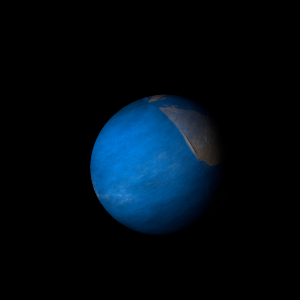|
|
Space Astro
|
Info for exoplanet "Shiro"
| Scientific (actual) data |
|---|
| Name | Kepler-726 b |
| Planet status | Confirmed |
| Radius | 0.291 |
| Orbital period | 21.8045 |
| Discovered | 2016 |
| Updated | 2021-02-05 |
| Tconj | 2455020 |
| Publication | Announced on a website |
| Detection type | Primary Transit |
| Alternate names | 2MASS J19265215+4453143 b, K00920.01, KIC 8689031 b, KOI-920 b, KOI-920.01, WISE J192652.13+445314.3 b |
| Star name | Kepler-726 |
| Right ascension | 291.72° |
| Declination | 44.89° |
| Mag j | 13.81 |
| Mag h | 13.381 |
| Mag k | 13.329 |
| Star distance | 838 |
| Star metallicity | -0.09 |
| Star mass | 0.88 |
| Star radius | 0.85 |
| Star age | 4.47 |
| Star temperature | 5452 |
| Star alternate names | 2MASS J19265215+4453143, KIC 8689031, KOI-920, WISE J192652.13+445314.3 |
| Wikipedia article | Kepler-726 b |
Back
| |
| Fictional info (?) |
|---|
| Suggested name | Shiro |
| Planet type | Cold planet |
|
The surface of this cruel planet is dangerous because of the large and advanced plants, the "Gyube Oare", that feed in deep valleys while hunting a substance called "Chigata Bya". The Gyube Oare are not related to Zahoze Pa, have 5 eyes and vary in length from 70 to 130 meters. Most Gyube Oare can survive temperatures from 150 to 250°C but are killed by very low gravity. |
| Estimated population | 5000000000 |
| Atmosphere | Oxygen | 82% |
| Water | 14% |
| Methane | 2.1% |
| Carbon dioxide | 1.4% |
| Atmospheric pressure | 2.5 bar |
 |
| No known satellites |
| Google search for Shiro |
|
Website by Joachim Michaelis
|
|
|
|